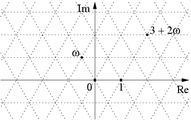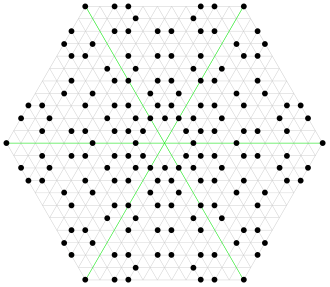Eisenstein integer
In mathematics, Eisenstein integers (named after Gotthold Eisenstein), occasionally also known[1] as Eulerian integers (after Leonhard Euler), are complex numbers of the form

where a and b are integers and
is a primitive (hence non-real) cube root of unity. The Eisenstein integers form a triangular lattice in the complex plane, in contrast with the Gaussian integers, which form a square lattice in the complex plane. The Eisenstein integers are a countably infinite set.
Properties
The Eisenstein integers form a commutative ring of algebraic integers in the algebraic number field Q(ω) — the third cyclotomic field. To see that the Eisenstein integers are algebraic integers note that each z = a + bω is a root of the monic polynomial
In particular, ω satisfies the equation
The product of two Eisenstein integers a + bω and c + dω is given explicitly by
The norm of an Eisenstein integer is just the square of its modulus, and is given by
which is clearly a positive ordinary (rational) integer.
Also, the conjugate of ω satisfies
The group of units in this ring is the cyclic group formed by the sixth roots of unity in the complex plane: , the Eisenstein integers of norm 1.
Eisenstein primes

If x and y are Eisenstein integers, we say that x divides y if there is some Eisenstein integer z such that y = zx. A non-unit Eisenstein integer x is said to be an Eisenstein prime if its only non-unit divisors are of the form ux, where u is any of the six units.
There are two types of Eisenstein primes. First, an ordinary prime number (or rational prime) which is congruent to 2 mod 3 is also an Eisenstein prime. Second, 3 and any rational prime congruent to 1 mod 3 is equal to the norm x2 − xy + y2 of an Eisentein integer x + ωy. Thus, such a prime may be factored as (x + ωy)(x + ω2y), and these factors are Eisenstein primes: they are precisely the Eisenstein integers whose norm is a rational prime.
Euclidean domain
The ring of Eisenstein integers forms a Euclidean domain whose norm N is given by the square modulus, as above:
A division algorithm, applied to any dividend and divisor , gives a quotient and a remainder smaller than the divisor, satisfying:
Here are all Eisenstein integers. This algorithm implies the Euclidean algorithm, which proves Euclid's lemma and the unique factorization of Eisenstein integers into Eisenstein primes.
One division algorithm is as follows. First perform the division in the field of complex numbers, and write the quotient in terms of ω:
for rational . Then obtain the Eisenstein integer quotient by rounding the rational coefficients to the nearest integer:
Here may denote any of the standard rounding-to-integer functions.
The reason this satisfies , while the analogous procedure fails for most other quadratic integer rings, is as follows. A fundamental domain for the ideal , acting by translations on the complex plane, is the 60°-120° rhombus with vertices . Any Eisenstein integer α lies inside one of the translates of this parallelogram, and the quotient κ is one of its vertices. The remainder is the square distance from α to this vertex, but the maximum possible distance in our algorithm is only , so . (The size of ρ could be slightly decreased by taking κ to be the closest corner.)
Quotient of C by the Eisenstein integers
The quotient of the complex plane C by the lattice containing all Eisenstein integers is a complex torus of real dimension 2. This is one of two tori with maximal symmetry among all such complex tori. This torus can be obtained by identifying each of the three pairs of opposite edges of a regular hexagon. (The other maximally symmetric torus is the quotient of the complex plane by the additive lattice of Gaussian integers, and can be obtained by identifying each of the two pairs of opposite sides of a square fundamental domain, such as [0,1] × [0,1].)
See also
Notes
- Surányi, László (1997). Algebra. TYPOTEX. p. 73. and Szalay, Mihály (1991). Számelmélet. Tankönyvkiadó. p. 75. both call these numbers "Euler-egészek", that is, Eulerian integers. The latter claims Euler worked with them in a proof.